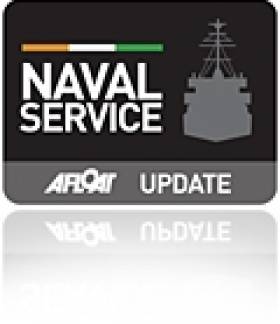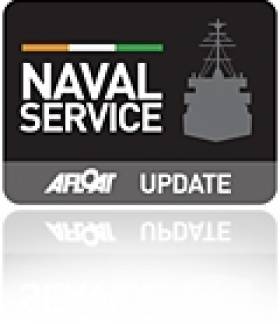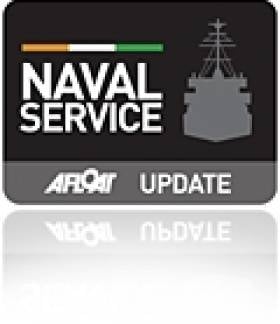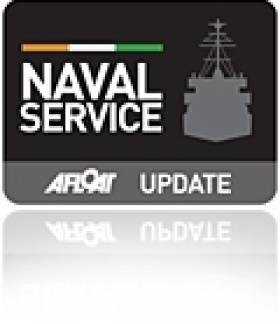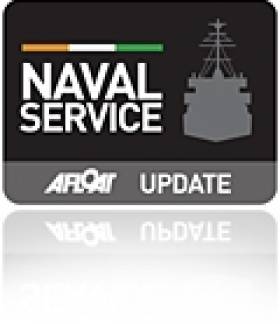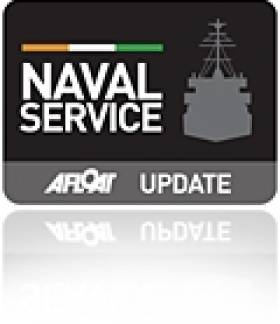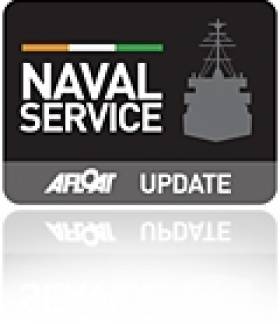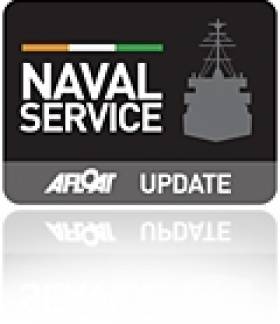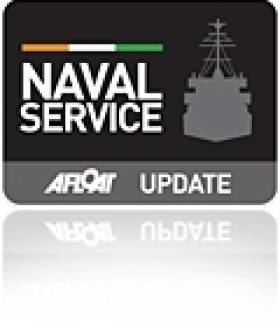Displaying items by tag: Navy
Irish Naval Service Divers Get Hand Held Sonar & Navigation System
#navy – The Irish Navy has acquired a 'Navigator Diver Held Sonar and Navigation System' manufactured by Shark Marine Technologies Inc. of Ontario, Canada. The navy divers believe the system equipped with forward-looking multi-beam sonar will assist them in their diving operations, in particular in search and recovery operations and underwater security.
The Naval Service Diving Section (NSDS) is the primary State diving team, carrying out varied tasks for a number of State Agencies.
Members of the NSDS used the NAVIGATOR system while training with the Royal Canadian Navy's fleet diving unit, according to the Ottawa Citizen newspaper.
The device is used in ship hull inspections as well as to assist local civilian authorities in searching for drowning victims and underwater criminal evidence.
The use of the Navigators can, according to Shark marine, enhance the divers' situational awareness, their area coverage rate, and their personal safety by providing them with real time information regarding position, depth and heading, as well as an extended visual range through the use of an imaging sonar.
The Ottawa Citizen has more on this story here
New Flag Officer for Naval Service
#FlagOfficer- The Irish Times writes that a new flag officer, Cmdr Hugh Tully who has 36 years experience with the Naval Service has been appointed.
Cmdr Tully takes over the role of Flag Officer Commanding Naval Service from Rear Admiral Mark Mellett, who as previously reported on Afloat.ie, was promoted last month to Defence Forces deputy chief of staff – the first time a Naval Service officer has held this senior position.
Cmdr Tully was Officer Commanding Naval Operations at Naval Base in Haulbowline, Cork. He has commanded the flagship L.É. Eithne (P31), L.É. Aoife (P22) and L.É. Orla (P41). Tully also received award medals for overseas service in Isreal and Lebanon with UNIFIL (1986) and UNTSO (2003-2005).
His appointment comes as the service is due to take delivery of two new OPV vessels, the first Afloat.ie adds the L.É. Samuel Beckett was 'floated-out' last month at a shipyard in north Devon.
Second Fishing Detention by L.E. Aoife off Cork Coast
#TrawlerDetained – An Irish registered fishing vessel was detained by the Naval Service OPV OPV L.É. Aoife (P22) on Wednesday approximately 40 nautical miles South East of Cork.
The detention was in relation to an alleged breach of fishing regulations. This is the second detention carried out by L.É. Aoife this week when a UK registered fishing vessel was involved and also off the Cork coastline.
The latest detained vessel is being escorted by to Cobh, it is expected to arrive alongside tonight, where it will be handed over to An Gardaí Síochána.
In total the Naval Service has boarded 931 vessels and this is the 15th vessel detained by the Naval Service so far this year.
UK Registered Trawler Detained by Naval Service
#TrawlerDetained – The Naval Service OPV L.É. Aoife (P22) detained a fishing vessel registered in the UK approximately 70 nautical miles south of Cork.
The detention was in relation to an alleged breach of fishing regulations.
According to the Naval Service the vessel was in the process of being handed over to the UK Maritime Management Office and expected to leave Irish waters and return to a UK port last night.
This latest incident brings to 926 the total number of vessels boarded by the navy in 2013 and the fourteenth vessel detained so far this year.
Former Atlantic Dawn Supertrawler Detained in Irish Waters
#Supertrawler - The Irish Times writes that the Naval Service OPV LÉ Roisín (P51) has detained one of the world's largest fishing vessels, the former Irish flagged Atlantic Dawn , for alleged infringements in Irish waters.
The 144-metre supertrawler, which is now Dutch-owned and registered and renamed as Annelies Ilena , was escorted into the vessels former homeport of Killybegs, Co Donegal, last night as part of a joint Naval Service - Sea Fisheries Protection Authority (SFPA) surveillance operation.
The vessel, which is the largest ever detained in an exercise of this type in Irish waters, was handed over to the Garda Siochána for suspected infringements relating to "high grading" of fish.
According to the Naval Service this vessel is the largest ever detained by the Naval Service and is considered to be one of the largest fishing vessels in the world. The detention of Annalies Ilena brings to 922 the number of boardings conducted this year by the Naval Service and this is the thirteenth vessel detained for alleged infringements of fisheries regulations in 2013.
Navy Detain Irish Trawler off Waterford Coast
#DetainedTrawler – The Naval Service's CPV LÉ Ciara (P42) detained an Irish registered fishing vessel last week in an area approximately 20 nautical miles off the south Waterford coast.
The vessel was detained for an alleged breach of fishing regulations. This is the twelfth detention made by the Naval Service this year following 901 boardings.
The fishing vessel hauled its nets and was escorted by the LÉ Ciara to Cobh and was handed over to the Gardaí.
#OPVnewbuilds – L.E. Samuel Beckett, the first of a pair of newbuild OPV vessels under construction for the Naval Service was floated-out earlier this month from a north Devon shipyard, writes Jehan Ashmore.
As previously reported on Afloat.ie, the floating-out of the newbuild OPV PV90 class (enhanced Roisin-class) was deferred to this month. Originally it was planned to have taken place the proceeding month from Babcock Marine's shipyard in Appledore.
L.E. Samuel Beckett is expected to be delivered by March 2014. She is a direct replacement of the former L.E. Emer whose adopted 'homeport' was Cork City. Speculation as to if the newbuild will take her predecessor's homeport remains the decision of the Department of Defence.
Yesterday the 'Emer' departed the Naval Base on Haulbowline Island to nearby Cork Dockyard where her owners, Uniglobe Group are to upgrade the vessel for her new role in the Niger Delta.
The 89m L.E. Samuel Beckett is to be followed by the second OPV L.E. James Joyce and likewise this newbuild is to be delivered a year apart in early 2015.
As previously reported in May 2012, senior representatives of the Naval Service and the Department of Defence attended the ceremony at the UK shipyard which won the €99m contract in 2010 to build the pair. Notably the PV90's are to feature drones or "unmanned aerial surveillance vehicles" and robotic submersibles.
The same shipyard near Bideford, also built sections for the first of a pair of new Royal Navy QE-class aircraft-carrier, HMS Queen Elizabeth. On Monday the final module of the 'ski-ramp' for the ship's massive hull was slotted into place at Babcock Marine's Rosyth dockyard.
Leading Defence Forces Role for Naval Service Commodore
#NavalLEADER - Alan Shatter, Minster for Justice has promoted a Naval Service leader to the position of Defence Forces deputy chief of staff for the first time in the State's history.
Commodore Mark Mellett was confirmed in the new position by Cabinet today, the promotion is in recognition of the importance of the maritime economy and patrolling one of Europe's largest sea areas.
For more on this story Lorna Siggins of The Irish Times reports.
Navy’s Retired LE Emer Sold for Role in Niger Delta
#EmerNIGERIA– As previously reported, the former Naval Service vessel LE Emer, which stood down last month after 35 years has been sold to a new owner who says he's unsure on private or security role for the vessel in the Niger Delta.
The vessel was sold at auction in Cork yesterday for €320,000 to London based Nigerian businessman Cyprian Imobhio.
Mr. Imobhio, chief executive and managing director of Uniglobe Group, said he had got the LE Emer, stripped of its armaments, for a good price, but he was reluctant to say it was a bargain. "It was a good price - but I would have preferred to get her for €200,000" he said with a smile.
Speaking following the auction at the Carrigaline Court Hotel in Co Cork where he saw off two rival bidders after bidding rose quickly from an opening gambit of €50,000, Mr Imobhio said he was impressed by the LE Emer when he first saw her at Naval Service HQ at nearby Haulbowline.
For much more on this story, The Irish Times reports.
L.E. Emer Sold to Nigerian for €320,000
#EmerSOLD– A Nigerian company director has brought the former Irish Naval Service OPV L.E. Emer (P21) at auction for €320,000 reports RTE News.
The new owner has yet to decide whether to convert it for pleasure use or use it as a commercial security ship off west Africa. There were two other bidders, one from Cork and the other based in the UK.
Afloat.ie adds that the public auction was organized by auctioneer Dominic J. Daly at the Carrigaline Court Hotel outside Cork City.
The 1978 built 1,019.5 displacement tonnes offshore patrol vessel was last month officially decommissioned following a ceremony held in Cork City quays attended by Flag Officer Commanding the Naval Service Cmdr. Mark Mellett.
She subsequently returned to the Naval Service basin on Haulbowline Island where she was made open for inspection by potential buyers.
Her final patrol having taken place in late September which took in farewell calls among them to Dublin Port and a special cruise for former crew.
A pair of Pielstick 6-cylinder Diesels powered the ship over a distance of approximately 518,000 miles during the course of a career spanning 35 years.
According to the auctioneer, L.E. Emer's nearest sister L.E. Aoife (P22) which was completed only two years later and also launched at Verolme Cork Dockyard (V.C.D.) is to be put on the market in a year's time.
The design origins of L.E. Emer derive from the Naval Service's first custom-built vessel the L.E. Deirdre also launched from the V.C.D. shipyard in 1972 at Rusbrooke near Cobh. She was decommissioned in 2001 and sold for €190,000 and converted into a luxury yacht.
This will eventually leave the final 'Emer' class member L.E. Aisling (P23) to remain in the current seven-strong fleet. A pair of replacement newbuilds of the enhanced 'Roisin' or PV90 class are on contract from Babcock Marine.
The first newbuild L.E. Samuel Beckett (to be floated-out next month) in Appledore, north Devon is to be delivered early next year. Her sister L.E. James Joyce is scheduled to enter a year later in early 2015.


























